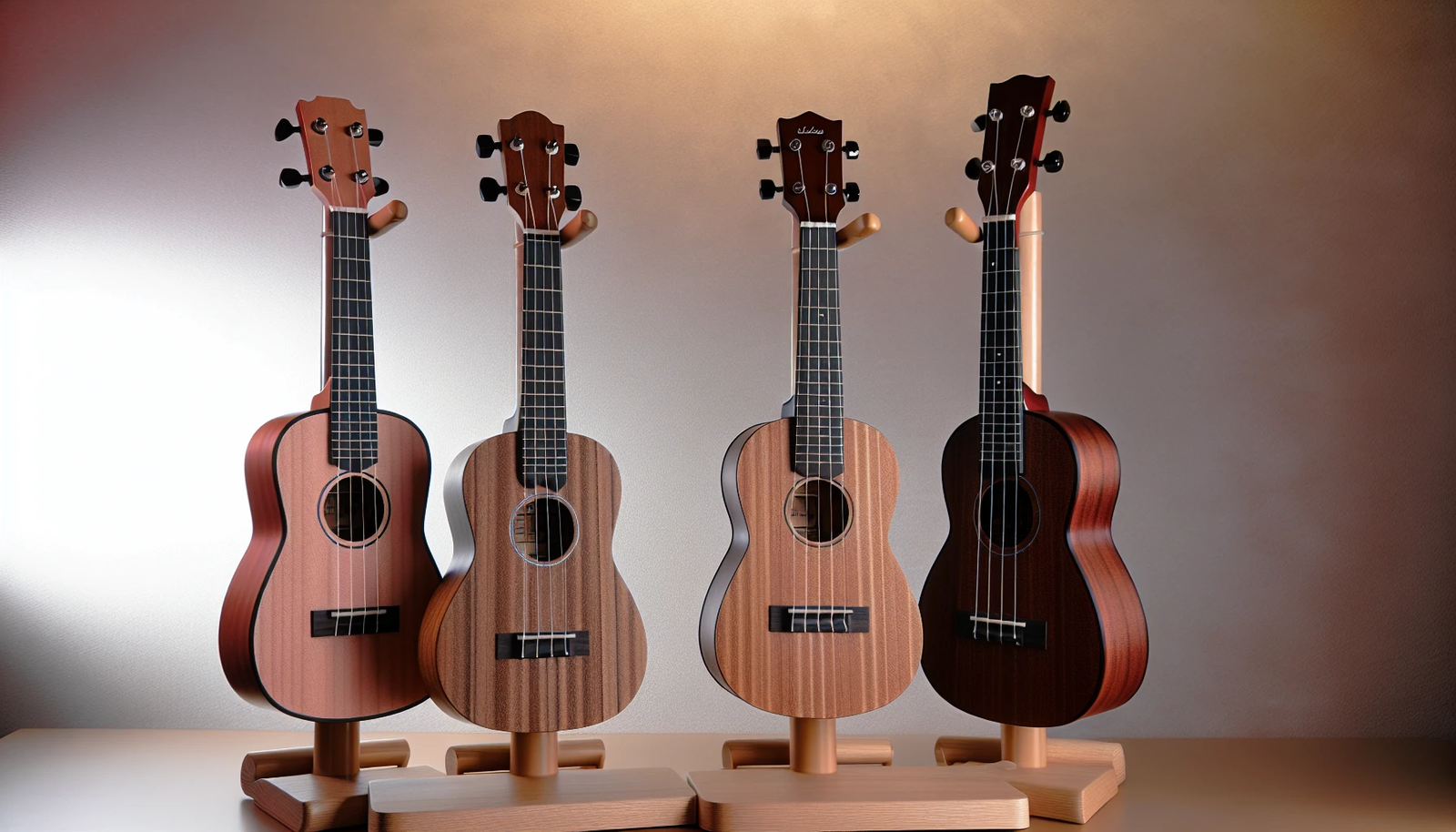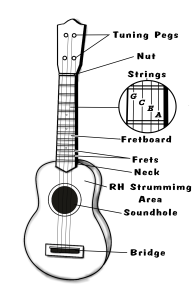Have you ever dreamed of playing a musical instrument but felt overwhelmed by the learning curve? Enter the ukulele, a friendly, affordable, and incredibly versatile instrument that is perfect for beginners and experienced musicians alike. With its small size, nylon strings, and simple chords, the ukulele offers a gateway to the world of music that is both enjoyable and accessible. Let’s embark on this exciting journey and learn to play ukulele!
Learn to Play Ukulele – Key Takeaways
- Discover the world of ukulele playing with helpful tips on selecting the perfect ukulele size for you as well as the basics of holding and tuning your instrument.
- Learn basic chords to play a variety of songs and practice chord transitions.
- Study different strumming patterns and techniques.
- Play your first song and expand your ukulele experience.
- Join the community to receive support in learning this enjoyable instrument.
Discovering the Ukulele: A Beginner’s Primer
The ukulele, especially the concert ukulele, has been captivating the hearts of music lovers for decades. From iconic musicians like George Harrison to contemporary artists such as Billie Eilish and Grace VanderWaal, the ukulele has been showcased in a variety of musical styles and genres.
What makes the ukulele so appealing is its ability to:
- Bring people together
- Create a fun and social atmosphere
- Allow everyone to learn to play a few songs
- Enable players to share their love for music
If you’re new to the world of ukuleles, you’ll find that learning the instrument is quite achievable. The ukulele is known for its ease of play, affordability, and relatively quick learning curve. You can start playing your favorite songs promptly with a few basic chords and strumming patterns. So, what can you expect from this musical journey? You’ll learn valuable tips for selecting the right ukulele, advice for tuning and strumming, and some easy chords and songs to get you started.

What makes the ukulele easy to play
The ukulele’s small size, nylon strings, and simple chords make it an easily playable instrument for beginners. Unlike a guitar, which has six strings and can be physically demanding to play, the ukulele has only four strings, making it less intimidating for newcomers. Moreover, the nylon strings are gentler on the fingers, allowing for more comfortable and extended practice sessions.
As you learn ukulele chords and progressions, you’ll realize that many songs require only a few basic chord shapes, making it an excellent instrument for those venturing into music.
What will it cost to learn to play the ukulele
Learning to play the ukulele is quite affordable compared to many other instruments. A decent beginner ukulele can be purchased for as little as $50 to $100, making it an accessible option for those on a budget. As for lessons, the cost can range from $30 to $50 per individual lesson, depending on the instructor’s expertise and the adaptability of the lessons.
There are also many free online resources, like video lessons and tutorials, that can help you enhance your skills without spending much.
What is the time commitment to learn to play ukulele for beginners
The time commitment for a beginner to learn the basics of playing the ukulele can vary, depending on factors such as previous musical experience, natural talent, and dedication to practice. However, on average, it is suggested that a beginner should practice for about 45 minutes per day for a month, or approximately 20 hours of focused practice.
With consistent practice and determination, you’ll soon find yourself strumming along to your favorite tunes and impressing your friends and family with your newfound musical skills.
Choosing Your First Ukulele
Selecting the right ukulele for your needs is an important step in your musical journey. Ukuleles come in various sizes, such as:
- Soprano: the smallest, producing a high, melodic tone
- Concert and tenor ukulele: offering a warmer, deeper tone
- Baritone: the largest of the group, with a rich, full sound that is closer to a guitar
When choosing your first ukulele, consider factors such as your budget, the desired tone, and the size of the instrument. While it might be tempting to go for the cheapest option, investing in a quality ukulele will ensure a better playing experience and a more enjoyable learning process. Don’t be afraid to try out different sizes and models to find the perfect fit for your needs and preferences.

You can check out this post for more details: How to Choose the Perfect Ukulele Size.
And here’s a video of Jenny showing the different ukulele sizes:
Anatomy of the Ukulele
Comprehending the various parts of the ukulele and their functions is a key aspect of mastering the instrument. A ukulele consists of several parts, including the:
- tuning pegs
- nut
- strings
- fretboard
- frets
- neck
- soundhole
- bridge

Each of these parts plays a crucial role in producing the unique sound of the ukulele.
For example, the sound hole, located on the body of the ukulele, helps to amplify the sound produced within the instrument. The bridge, on the other hand, transfers the strings’ vibrations to the soundboard, which in turn amplifies the sound. Familiarizing yourself with the anatomy of the ukulele will not only help you understand how the instrument works but also allow you to maintain and troubleshoot any issues that may arise.
The Basics of Holding and Tuning the Ukulele
Before you start playing songs and practicing chords, it’s vital to grasp the basics of holding and tuning the ukulele. Proper posture, hand placement, and tuning are critical factors in producing the best possible sound and ensuring a comfortable playing experience.
Proper Ukulele Posture
Correctly holding the ukulele is key to producing the best sound and ensuring comfort. Start by cradling the ukulele with your right arm, taking on most of the weight. Avoid pushing on the neck with your thumb, and instead, support the ukulele with your forearm.
Tilt the neck upward at a 45-degree angle, keeping your wrist straight, and ensure that the instrument is not pressed too tightly against your body. This comfortable and relaxed posture will allow you to play with more accuracy and agility while preventing any discomfort or strain, especially for your index finger, middle finger, and ring finger.
Fine-Tuning Your Instrument
Tuning your ukulele is necessary for producing the best sound and ensuring the accuracy of your chords and melodies. For beginners, using a digital tuner or a tuner app on your phone is the most straightforward method. Play each string and adjust the tuning peg until the tuner shows that the string is in tune.
Alternatively, you can use a reference pitch from another instrument, such as a piano or guitar, to tune your ukulele. Remember to tune each string individually, starting with the G string, to achieve the standard G-C-E-A tuning.

Learn to Play Ukulele Chords – Start with the Basic and Essential Chords
After understanding the basics of holding and tuning your ukulele, it’s time to learn some basic chords to start playing songs. With just a few basic chords, you’ll be able to play a wide variety of songs, from pop hits to classic folk tunes. The chords C, F, Am, C7 and G7 are especially versatile and easy to learn, making them an excellent starting point for beginners. To learn these chords, refer to chord diagrams that show the correct finger placement on the fretboard. These chords are also the chords covered in Book 1 of our Beginning Ukulele Songs Series, “21 Songs in 6 Days”.

Are you struggling with strumming?
With our book and course, you’ll become a fluent 3-chord strummer.
Switching Between Chords with Ease
The ability to transition smoothly and efficiently between chords is a vital skill for any ukulele player. As you practice playing different chords, focus on maintaining a steady rhythm and ensuring that each string is sounding correctly. Start by practicing simple chord transitions, such as switching between the F and C7 chords or the C and G7 chords. As you become more comfortable with these transitions, gradually increase your strumming speed and incorporate more complex chord progressions.
To improve your chord transitions, try the following techniques:
- Practice lifting your fingers slightly off the fretboard as you switch between chords, allowing for more fluid and seamless movement.
- Set a timer for 60 seconds and practice transitioning between chords within that timeframe to build speed and accuracy.
- With consistent practice and focus, you’ll soon be able to switch between chords with ease, making your playing more dynamic and expressive.
Strumming Patterns and Techniques
Upon mastering the basic chords, it’s time to learn diverse strumming patterns and techniques to elevate your playing style. Strumming patterns are the rhythmic foundation of a song, dictating the flow and groove of the music. By learning different strumming patterns and techniques, you can add variety and depth to your playing, making your performances more engaging and dynamic.
Finding Your Strumming Groove
To find your unique strumming pattern, start by practicing basic downstrokes and upstrokes and experimenting with different rhythms and tempos. As you become more comfortable with these basic techniques, try incorporating alternate strumming patterns, such as down-up-down-up or down-down-up patterns.
Bear in mind, regular practice is the key to refining your ukulele strumming techniques. Keep practicing regularly, and you’ll see progress over time as you develop your own distinctive strumming groove.
Building Finger Strength and Dexterity
Building finger strength and dexterity is critical for playing the ukulele smoothly and accurately. To build finger strength, practice fretting different strings and frets with each finger, focusing on applying even pressure and producing a clean sound.
By incorporating these targeted exercises into your daily practice routine, you’ll notice significant improvements in your finger strength and dexterity, making your ukulele playing more enjoyable and effortless.
Learn to Play Ukulele Songs: Playing Your First Song

Having learned the fundamentals of holding, tuning, strumming, and playing chords on the ukulele, you can now put your skills into action by playing your first song. Let us know learn to play ukulele songs! Choose a simple song that uses the basic chords you’ve learned, such as “Lava” from the Disney animated short film of the same name. This charming song uses the chords C, F, and G7, making it an ideal choice for beginners.
Here is Jenny’s tutorial for “Lava”:
Expanding Your Ukulele Experience
Practice Makes Perfect: Daily Exercises
To truly excel at the ukulele, you must establish a regular daily practice routine. By setting aside time each day to focus on improving your skills and technique, you’ll make significant progress in your playing abilities. In addition to practicing chords and songs, consider incorporating targeted exercises into your routine to build finger strength, dexterity, and overall musicianship.
Some effective daily exercises include fretting hand workouts and practicing chord shapes without strumming. Remember, practice makes perfect – the more time you dedicate to your ukulele practice, the more skilled and confident you’ll become.
Broaden Chord Library
As your ukulele playing proficiency improves, you might want to broaden your chord library by learning more complex chords and progressions. By broadening your repertoire of chords, you’ll become a more versatile player, able to tackle a wider range of songs and styles. This can be especially helpful when you’re exploring different genres of music, as certain styles may require unique chord structures and progressions.
Incorporating Music Theory
Including music theory in your ukulele practice can deepen your understanding of the instrument and improve your playing abilities. Music theory encompasses the study of the principles and practices of music, including concepts such as:
- Notes
- Chords
- Scales
- Rhythm
- Harmony
By learning music theory, you’ll gain a greater understanding of how music works and how to apply this knowledge to your ukulele playing.
Our books as well as course as course resources and lessons can help you dive deeper into music theory specifically for the ukulele.
Video Lessons and Online Resources
In the current digital era, a plethora of video lessons and online resources are available to aid you in learning and improving your ukulele playing. From beginner tutorials to advanced techniques, you can find a wealth of information and guidance at your fingertips, making it easier than ever to develop your skills and master the ukulele.
Most of our books include free courses but we also have specific courses and kits that can help you expand your ukulele experience. You can also check our YouTube channel as well as other ukulele YouTube channels for free ukulele tutorials and lessons. By utilizing these resources and supplementing your practice with video lessons, you’ll be well on your way to becoming a skilled and confident ukulele player.
Ukulele for Everyone: Joining the Community
Engaging with the ukulele community can offer priceless support, encouragement, and motivation as you proceed with your musical journey. By joining local groups, participating in online forums, and engaging with fellow ukulele enthusiasts on social media, you’ll not only expand your musical knowledge but also forge lasting connections with like-minded individuals who share your passion for the ukulele.
To find local ukulele groups or jam sessions, visit websites such as www.meetup.com or search for ukulele clubs and gatherings in your area. Online forums and communities provide a platform to connect with other ukulele players, ask questions, and share your progress. By engaging with the ukulele community, you’ll enrich your playing experience and find a supportive network of fellow musicians to help guide and motivate you along the way.
Frequently Asked Questions
How long does it take to learn the basics of playing the ukulele?
With consistent practice, the basics of ukulele playing can be learned in 1-4 months, including the ability to switch between chords and play a strumming pattern.
What is the average cost of a beginner ukulele?
On average, a beginner ukulele typically costs between $50 and $100.
What are some popular songs for beginners to learn on the ukulele?
Popular ukulele songs for beginners include “Lava,” “Hey, Soul Sister,” “I’m Yours,” and “Riptide.”
How can I improve my strumming techniques on the ukulele?
To improve your strumming techniques on the ukulele, practice regularly with steady rhythm and experimenting with different patterns and tempos.

Are you struggling with strumming?
With our book and course, you’ll become a fluent 3-chord strummer.




